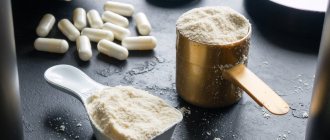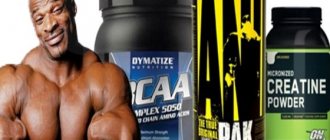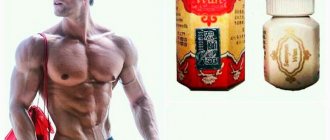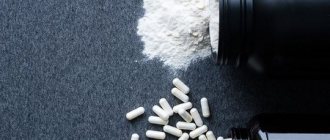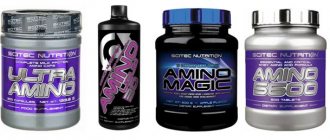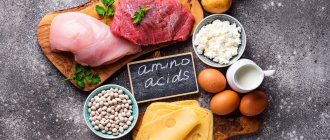Whey protein is used in sports nutrition. It has been proven experimentally and in practice that it affects the growth of new cells and muscle mass gain. The second purpose is for weight loss (“drying” the body). It also restores athletes’ strength after tiring training, endurance, and strengthens the immune system. The biological supplement is recommended to maintain health levels for those who do not “light up the Olympic stars.” For each category, the norms and time of consumption of biological additives are determined.
What is whey protein?
Biochemists obtained a substance with a “pure” protein content from whey, a residual product after the preparation of cheeses. Over the course of evolution, the protein content of whey protein has increased from 50 to 99 percent. For comparison: chicken meat contains up to 20 percent protein. To get the average daily requirement of building material (130 -150 grams of protein), an athlete must eat 5 - 10 servings of chicken. At the same time, it “burdens” the body with fat: per gram of protein there are 0.7 grams of fat.
Whey protein is free of fats, peptides, lactose, and creates a nitrogen balance that stimulates anabolism and muscle growth. It belongs to the “fast” proteins: it instantly saturates cells with protein with essential amino acids:
- tryptophan;
- leucine;
- isoleucine;
- lysine;
- tyrosine;
- cystine;
- valine;
- methionine;
- threonine;
- phenylalanine.
Homemade smoothie to increase muscle mass
You can make your own protein shake. For this, medium-fat milk or kefir is usually used. Carbohydrates include fruits or grains.
For example:
- Milk 2.5% fat 400 ml;
- Bananas: 150 g;
- Honey: 30 g.
Or
- Kefir 2.5 fat content 600 ml;
- Cherries (can be frozen) 200 ml;
- Water 100 ml.
Use a blender to mix. This drink will have 12-20 grams of protein, 45-75 carbohydrates and about 450 calories.
You can use other sources of protein, such as cottage cheese and eggs:
- Low-fat cottage cheese: 200 g;
- Egg (white): 3 pcs;
- Bananas: 150 gr;
- Milk: 250 ml.
Here, with the same approximate calorie content, you will get almost 50 grams of protein. Measuring nutritional content more accurately is difficult, even with a kitchen scale.
Types of Whey Protein
Using technological methods, three types of biological additives were obtained:
- Concentrated whey protein contains 50-60 percent protein. Contains fats and lactose. Calorie product. Sports trainers recommend taking the concentrate to bodybuilding beginners. The body absorbs a pleasant (with different tastes) biological additive in an hour and a half.
- Isolate is at the top of protein products: in 100 grams of the supplement, 90 grams are protein. It contains residual amounts of fats and peptides. The body copes with the breakdown of whey isolate in half an hour.
- Hydroisolate – con protein: 99 per 100 grams. The “mono” composition of the hydroisolate is tasteless, but is absorbed in 10-15 minutes.
Now that you know the structure of the three types of whey protein and the breakdown time, let's create a schedule for taking the dietary supplement.
Research
Many studies have been conducted on the harm of protein and its effect on the body of adolescents. No negative effects were found. There is only one danger, but it has a psychological basis. A teenager who started with “weak” supplements may eventually switch to more dangerous ones, for example, steroids.
The problem is that the child is too susceptible to what is shown on TV. He wants to be the most beautiful, to arouse the envy of his peers, and girls like him. For this reason, he may take dangerous drugs without even thinking about their negative effects.
Time of administration and dose
To take protein, calculate the daily biorhythms and biochemical processes occurring in the body in the morning, afternoon and evening. Apply the correction factor on days of training and sports competitions.
Remember: the rule “more is better” does not apply when taking whey protein. The daily norm for athletes is calculated by a sports doctor together with a nutritionist. They take into account the amount of natural proteins from the food of the daily diet, add concentrate at a general calculation: 2 grams per kilogram of the bodybuilder’s weight. For a healthy diet for non-athletes, a different formula is used. When compiling it, the nutritionist relies on the age, gender, constitution of the ward.
What are proteins?
Protein can be of plant or animal origin
Basically, proteins enter the body along with various meat and dairy products. This is not only meat, fish and milk itself, but also cottage cheese, cheese, eggs, poultry and other similar products. But these are not the only sources of protein for the human body. This protein is usually called animal protein.
Another source of protein is plant foods. The most valuable sources of this kind include: peas, beans, mushrooms and nuts. Those who do not eat animal products can get the protein they need from these types of plant foods.
Which type of protein is healthier? The one that comes with animal foods or the one that comes with plant foods? Animal protein is richer, higher quality and balanced in composition.
As you know, the human body’s protein needs include the need to obtain about a hundred different amino acids in the right quantities. This kind of food contains all the necessary elements.
Products of plant origin contain mainly those proteins that are involved in the growth of various tissues and organs. Fruits and berries have the lowest protein content compared to other products.
Morning reception
During 8 hours of sleep you do not receive food, the body uses up evening energy reserves in the form of amino acids (the process of destruction of muscle tissue) and glycogen from the liver. At the same time, muscle tissue is catabolized due to the steroid hormone cortisol. By destroying muscles, it pushes the body to deposit fat. To remove destructive processes, take a “fast” protein shake in the morning. At your morning meal, nutritionists advise having breakfast with a portion of whey protein hydrolyzate.
Destructive forces do not affect muscle tissue, having received a dose of beneficial biological additives.
Principles of nutrition
It is known that weightlifters need a lot of protein to sculpt their body. Beginners, carried away by protein shakes, forget about micro- and macroelements, vitamins, amino acids, antioxidants, which are necessary for the normal functioning of the human body, regardless of his attitude to sports.
The best option to get this whole “healthy set” is to eat natural foods:
- meat;
- fish;
- vegetables;
- fruits;
- cereals;
- sour milk.
Successful nutrition for a bodybuilder is based on the following “three pillars”:
- A good appetite.
- Balanced menu.
- Strict eating regimen.
An effective gain of lean muscle mass occurs with an increased caloric intake. At the same time, the source of additional calories and the time when to eat them are important so that the gain does not come from fat deposits.
Reception frequency
It is common practice to eat three times a day. But this routine is not suitable for bodybuilders. Strenuous strength training requires a lot of energy, which will not be enough if more than three hours pass between breakfast, lunch and dinner. The muscles do not receive nutrition and stop growing, and this negates the efforts expended in the gym.
Thus, to build muscle mass, meals should be evenly distributed throughout the day, taking into account the interval between them no more than 3 hours.
It turns out that you need to eat (including small snacks) 5-6 times a day to ensure the uninterrupted formation of muscle tissue.
The optimal regime for gaining weight is to give the body an hour or two to digest, and then go to the gym. After the load, give the body 30-40 minutes to recover, and then eat something.
Calorie content of food
When food is processed in the body, energy is released, measured in calories, which is spent on maintaining vital functions, including building tissue. Effective muscle building occurs when the number of calories delivered with food exceeds their daily consumption.
The required amount of calories for a pumping athlete depends on his:
- individual basal metabolism, which is affected by weight, age and height;
- level of daily physical activity;
- body type.
The calculation is carried out in three stages:
- The total amount of energy required for life.
Men can calculate their indicators using the formula:
10 x B + 6.25 x R – 5 x L + 5, where
- B – weight in kilograms;
- P – height in centimeters;
- L – number of years lived.
- Calories needed to maintain current weight.
Special coefficients are used that reflect the daily load level:
- 1,275 – up to 3 workouts per week;
- 1,55 – 3-5;
- 1,725 – 5-7;
- 1.9 – more than 2 per day.
The value obtained in the first paragraph is multiplied by the corresponding coefficient.
- The number of calories an athlete needs to consume to gain weight.
The inherent ability of nature to gain weight quickly or slowly is taken into account by adding 15% or 20% to the figure obtained in step 2. So:
- those with a predisposition to be overweight (endomorphs) add 15%, as their weight grows quickly;
- thin men (ectomorphs) gain 20% as their weight increases slowly.
As a result of the calculations, a value is obtained that helps to build a nutrition program and, based on calorie indicators, select products for gaining muscle mass.
Proteins, fats and carbohydrates
Weightlifters who begin to master the rules of sports nutrition often make the mistake of giving preference to foods high in protein rather than including fats and carbohydrates in their diet.
In the body of an actively engaged athlete, when building muscle structure, complex hormonal processes take place that are impossible without fats. And without carbohydrates, you will not have the strength to withstand increased loads.
Only a balanced menu, including the required ratio of nutrients, allows you to build an effective diet for gaining muscle mass for men in order to achieve noticeable results in a short time.
This menu should contain:
- 30-35% proteins;
- 10-20% fat;
- 50-60% carbohydrates.
The averages given provide a range for individual adjustments based on body type, body type, and goals.
Water
Compliance with the drinking regime is an important component of protein nutrition.
For effective mass gain, you need to consume from 2 to 4 liters per day, depending on the weight of the athlete. You need to drink between meals. You should not wash down your food, so as not to disrupt the physiological processes of digestion that facilitate the absorption of nutrients.
Before training and after exercise
90 minutes before bodybuilding activities, a sports doctor recommends taking the concentrate. If you don’t have time, drink a mixture of whey isolate half an hour before going to the shells. Such preparation (saturation of muscles with amino acids) will provide the body with building materials, preventing it from using up muscle fibers. This way you will avoid muscle catabolism.
The tiring workout is over, the body is adjusted to further intake of protein supplements. He has reasons for this: the loads have reduced the level of amino acids, glycogen, and blood sugar. Urgent help for amino acid balance is to take whey hydroisolate. It takes 60 minutes to restore lost energy. Then you have dinner, giving preference to dairy products, fish, and lean meats.
Carbohydrate gels
If you have the opportunity to do long-term cycling exercise at home - on a treadmill, stationary bike or exercise bike - then you may notice a loss of concentration after a fairly quick period of time. In a confined space, we feel tired much faster than on the street, where the changing landscape and noticeable progress towards the goal make it easier to bear the load. To support your body, use energy gels - they will become a source of energy, and gels with caffeine will give you extra energy even after several hours on the bike station.
GU Liquid Energy Gel 60 g Lemonade
Carbohydrate gel with trace elements and amino acids
GU Liquid Energy Gel 60 g Coffee
Carbohydrate gel with trace elements, amino acids and caffeine
Nutrend Carbosnack Blue Raspberry 50 g
The caffeine contained in the carbohydrate gel will help restore concentration and improve performance.
SIS GO + Electrolyte 60 ml Salted Caramel
Carbohydrate gel with electrolytes provides the body with energy and restores salt balance
Whey protein during drying
Sports doctors and “advanced” weightlifters advise taking whey protein when working “for relief”, when “drying” the body.
They use the following algorithm:
- Morning “stop signal” for catabolic processes: one scoop of whey protein.
- Daily maintenance norm: reduction in the total calorie content of food, one or two servings of whey concentrate.
- Training cocktail: one hour before exercise and for 90 minutes after training.
- Combating nighttime catabolism: complex cocktail or casein.
Tasty and healthy
Those who are forced to fuel their muscles with protein mixtures for months note the cloying taste of protein supplements. To make the meal not only useful, but also enjoyable, nutritionists recommend mixing fruits and vegetables in a blender. Add honey, nuts, cinnamon, lemon balm with one dose of protein supplement.
Note that these are additional calories. People who want to lose weight cannot afford such variety. For them - an oatmeal shake that replaces a meal. The complex includes carbohydrates, a bit of fat, and a double portion of protein.
Complete breakfast ingredients:
- boiled oatmeal;
- cinnamon;
- apple;
- almond;
- 2 servings of protein;
- milk.
One recipe given. Change each ingredient, except whey, based on your own preferences.
Excess protein in the body
Of course, protein is vital for the body. But can it be used without any measure and what could be the danger? The absorption of excess protein requires a lot of calcium, which for this will be extracted from other tissues and organs of the body. It usually comes from bones. In this case, the body does not have time to compensate for it and the bones become fragile, and osteoporosis may develop.
Eating too much protein can also lead to elevated cholesterol levels, which increases your risk of developing heart disease. Also, an excess of protein can lead to a deficiency of vitamins in the human body.
Proteins are essential amino acids, as this video will prove:





